In the intricate tapestry of the natural world, spiders are among the common creatures. Spiders are arachnids, a class of arthropods that also includes scorpions, mites and ticks. There are more than 45,000 known species of spiders, found in habitats all over the world, (Source: National Geographic). There’s a spider with a cartoonish butt, spiders that can jump on demand, and cannibal spiders that look like pelicans.
Spiders can be Green, White, Yellow, Black, Orange, Purple or Maroon in color. Among the vast array of spider species, green spiders are easy to encounter in the environment. They are usually in shades of emerald, lime or moss and blend seamlessly with their leafy surroundings.
This article tries to look into various species of spiders that exhibit green coloration by discussing their diverse forms, behaviors and ecological significance.
List of Green Spiders
- Green Lynx Spider
- Magnolia Green Jumping Spider
- Cucumber green spider
- Triangle Crab Spider
- American Green Crab Spider
- The Green Huntsman Spider
- Green Australian Spider
- Green Mesh-weaver
- Lesser green lynx spider
- Speckled Garden Spider
- Slender green orb-weaver
- Green stretch spider
- Red-spotted Orbweaver
- Grass crab spiders
- Hygropoda Spiders
Facts And Description
Green Lynx Spider
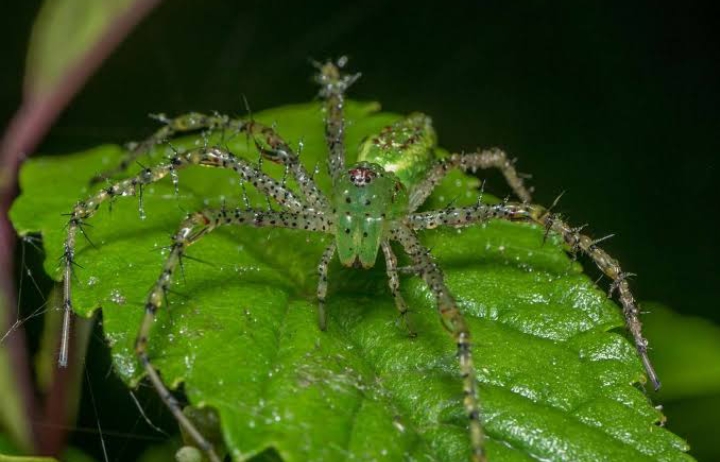
The Green Lynx Spider is commonly found in North and Central America, particularly in regions such as the United States, Mexico, and the Caribbean.
This spider is relatively small compared to other spider species, with females growing up to 5 mm in body length, while males are smaller.
The body of the spider is slender and cylindrical in shape. The body in general is green in color, though sometimes can vary in intensity from pale green to bright lime green.
You can easily spot this spider in habitats such as fields, meadows, gardens and shrubs. It constructs its web among plants, often choosing flowers or leaves as the hunting sites.
While the venom is not considered harmful to humans, it can cause localized pain, redness and swelling if bitten. However, these spiders are generally non-aggressive and rarely bite unless provoked or handled.
Facts Table
| Scientific Name | Peucetia viridans |
| Family | Oxyopidae |
| Type | Lynx spider |
| Size | Females are 5-7 millimeters. Males are 4-5 millimeters. |
| Lifespan | 7 months to 1 year |
| Habitat | Gardens, meadows, forests and hedgerows. |
| Hunting Technique | Ambush and Web |
| Breeding season | Summer months |
| Food | Flies, mosquitoes and aphids, crickets, ants, spiders, and soft-bodied insects |
| Predators | Birds, larger spiders, mantises and wasps |
Also Read: Different Types of White Spiders
The Magnolia Green Spider
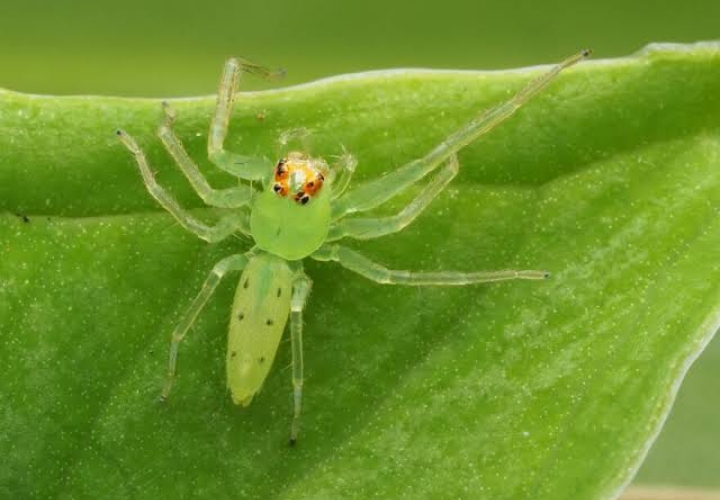
The Magnolia Green Jumping Spider, scientifically known as Lyssomanes viridis is primarily found in the southeastern parts of the United States, including states such as Florida, Georgia, Alabama, Mississippi, and Louisiana.
This is a small-sized spider, with males measuring around 4 and 6 millimeters in length, while females are somehow larger, about 6 or 7 millimeters. The carapace (the hardened front part of the spider’s body) is pale green, while the abdomen is usually a darker shade of green. The legs also exhibit the same green color.
True to its common name, the species prefers the broad leaves of magnolia trees, particularly in warm, humid forests. It can also be found in dryer climates on oak, maple, pine and other places with ample vegetation, and even residential areas.
The Magnolia Green Spider is a diurnal active hunter that relies on both its exceptional vision and jumping ability to capture prey.
Facts Table
| Scientific Name | Lyssomanes viridis |
| Family | Lyssomanes |
| Type | Jumping |
| Size | Females are 4-6 millimeters. Males are 6-7 millimeters. |
| Lifespan | 5 months to 1 year |
| Habitat | Gardens and humid forests, |
| Hunting Technique | Ambush and Web |
| Breeding season | Summer months |
| Food | Flies, mosquitoes and aphids, crickets, ants, spiders, and soft-bodied insects |
| Predators | Birds, larger spiders, mantises and wasps |
Cucumber green spider
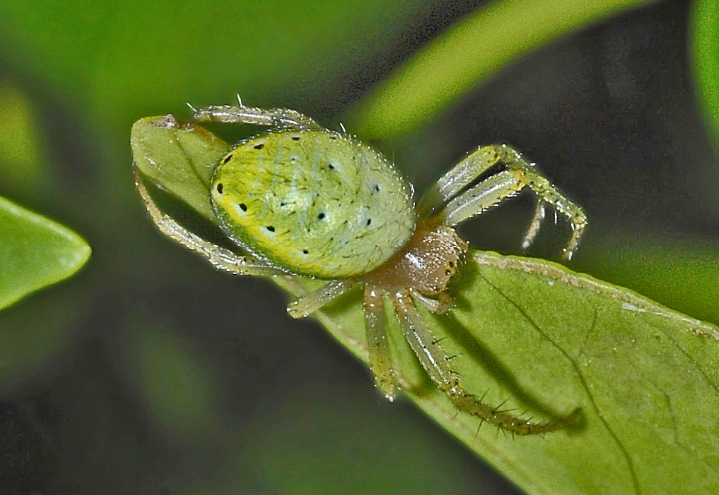
Cucumber green spider also referred to as the “cucumber spider,” is a species of orb-weaving spider. It is found across Europe, Africa, Western Asia, Central Asia and Japan.
Females are about around 5 and 7 millimeters in body length, while males are smaller, measuring 4 and 5 millimeters. The body color is usually greenish but sometimes it can be pale yellow.
The cephalothorax (head and thorax) usually has a darker pattern, often consisting of two longitudinal stripes. The abdomen may display a dark median stripe and pairs of dark lateral spots.
Like other orb-weaving spiders, Araniella cucurbitina constructs a distinctive circular web composed of sticky silk threads.
This spider is an ambush predator, patiently waiting at the center of its web or in a nearby hiding spot. It feeds on pests like flies, mosquitoes and aphids.
The lifespan of Araniella cucurbitina is relatively short, typically ranging from several months to a year.
Facts Table
| Scientific Name | Araniella cucurbitina |
| Family | Araneidae |
| Type | Orb-weaving spiders |
| Size | Females are 5-7 millimeters. Males are 4-5 millimeters. |
| Lifespan | 7 moths to 1 year |
| Habitat | Gardens, meadows, forests and hedgerows. |
| Hunting Technique | Ambush and Web |
| Breeding season | Summer months |
| Food | Flies, mosquitoes and aphids, crickets, ants, spiders, and soft-bodied insects |
| Predators | Birds, larger spiders, mantises and wasps |
Triangle Crab Spider
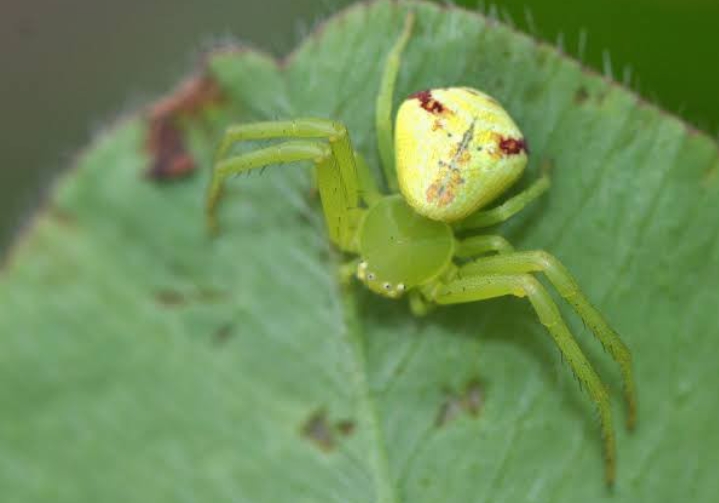
This spider is commonly referred to as the Triangle Crab Spider due to its triangular-shaped body. Its legs are positioned more like crab legs than spider legs.
It can be found across various regions from Africa, Europe, Asia, Australia to the Americas.
The adult females have a body length from 6 to 10 mm, while the males are about 4 to 6 mm in length. Females are heavy-bodied and mostly stationary, whereas males are slender and more motile. Overall, the body color can be pale yellow to green or even brown.
This spider is known to inhabit agricultural fields and urban areas. The Triangle Crab Spider is an ambush predator. It doesn’t build a web to catch prey like other spider species but relies on its camouflage and stealth ability to capture its prey.
On average, the lifespan of a Triangle Crab Spider is about one year. This includes the time from hatching as a spiderling to reaching maturity and reproducing.
Facts Table
| Scientific Name | Ebrechtella tricuspidate |
| Family | Thomisidae |
| Type | Crab Spider |
| Size | Females are 6-10 millimeters. Males are 4-6 millimeters. |
| Lifespan | 1 year |
| Habitat | Gardens, meadows, forests and shrublands |
| Hunting Technique | Camouflage and ambush |
| Breeding season | Summer months |
| Food | Flies, bees, wasps, beetles, butterflies, moths, and grasshoppers. |
| Predators | Birds, larger spiders, mantises, wasps Small Mammals and Reptiles |
Also Read: Different Types of Purple Spiders
American Green Crab Spider
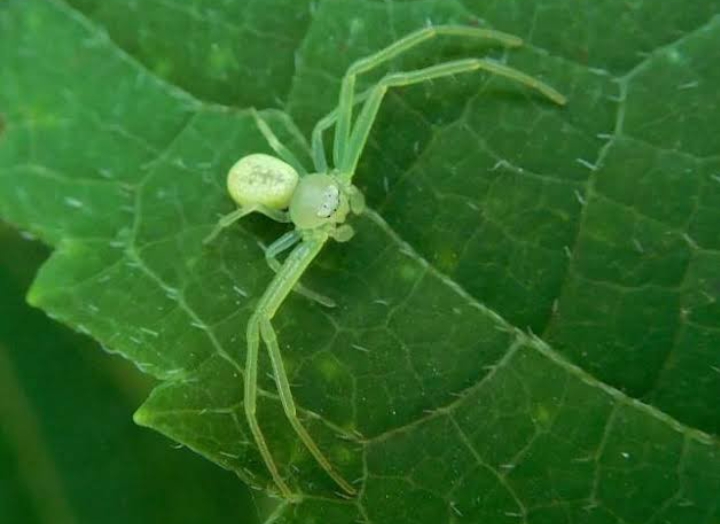
Misumessus oblongus also referred to as American Green Crab Spider is commonly found in the United States, Canada and Caribbean.
This spider species is most prevalent in the eastern parts of North America, such as the Atlantic Coast and the Great Lakes region. Its body shape is elongated and oblong, hence the species name “oblongus.”
The green crab spider has spines, and the entire body and legs are pale green to silvery white. The spider has eight legs and a pair of pedipalps. Like other crab spiders, its legs extend outward from the sides, and it can walk in any direction.
Most of the time the spider lives in vegetation and flowers. During the mating season, males actively search for females. After successful mating, the female lays eggs in a silken sac.
In the vegetations, the spider usually sits motionless on plants, waiting for insects to come within reach. When an insect comes near, the spider pounces quickly, using its long front legs to immobilize and capture it.
Female spiders tend to have longer lifespans compared to males.
Facts Table
| Scientific Name | Misumessus oblongus |
| Family | Thomisidae |
| Type | Crab Spider |
| Size | Females are 5 to 7 millimeters in length, while males are around 4 to 5 millimeters. |
| Lifespan | 9 months to 1 year |
| Habitat | Meadows, gardens, shrublands, forests and agricultural areas |
| Hunting Technique | Camouflage and ambush |
| Breeding season | Summer months |
| Food | Flies, bees, wasps, beetles, butterflies, moths, and grasshoppers. |
| Predators | Birds, larger spiders, mantises, wasps Small Mammals and Reptiles |
Green Huntsman Spider
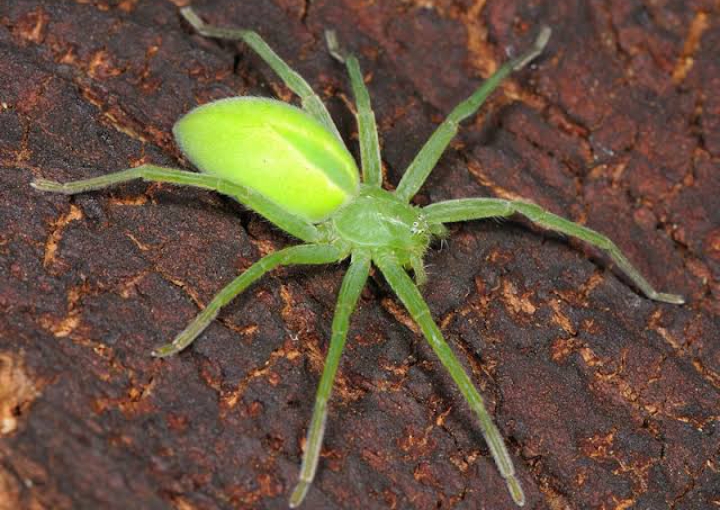
The Green Huntsman Spider is characterized by striking green coloration and it occurs naturally in Northern and Central Europe, including Denmark and southern Britain.
The Huntsman spiders can be found at the edges of forests, in dry meadows, in damp woodland clearings and rides, where they prefer grass and the lower branches of trees.
The Green Huntsman Spider displays sexual dimorphism, with females being larger than males. Adult females can reach a body length of about 18-20 millimeters, while males around 12 to 15 millimeters. The leg span of these spiders can extend up to 50 millimeters.
The cephalothorax and the long legs of the females are bright green, with a lighter green abdomen showing a darker green median stripe. The eight eyes are arranged in two rows and surrounded by white hairs.
Males are dark green-olive and have a narrower abdomen, with red sides and a red to red-brown median stripe bordered yellow. Young spiders have a yellow-brown cephalothorax, with dark marginal and median stripes.
Green Huntsman Spiders are usually active during the night. During the day, they hide in crevices, under bark, or within foliage. Unlike some other spiders, they do not build intricate webs to capture prey.
Female Green Huntsman Spiders can live for up to two to three years, while males have a shorter lifespan of around one to two years.
Facts Table
| Scientific Name | Micrommata virescens |
| Family | Sparassidae |
| Type | Crab Spider |
| Size | Adult females: 18-20 millimeters. Males are 12-15 millimeters. |
| Lifespan | 1-3 years |
| Habitat | Grassy areas and shrubbery |
| Hunting Technique | Camouflage and ambush |
| Breeding season | Summer months |
| Food | Flies, bees, wasps, beetles, cricket, butterflies, moths, grasshoppers and other spiders. |
| Predators | Birds, larger spiders, mantises, wasps Small Mammals and Reptiles |
Also Read: Different Types of Gnats
Green Australian Spider
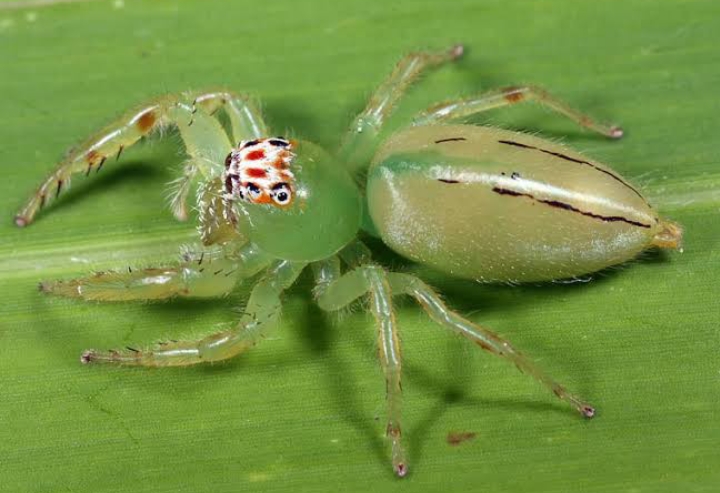
Mopsus mormon also referred to as Green Australian Spider or commonly called the green jumping spider is primarily found in Australia particularly Queensland. It also occurs in New Guinea, northern New South Wales, the Northern Territory, northern Tasmania and Western Australia.
Its distribution spans across a wide range of habitats within these areas. They can be found on vegetation, tree trunks, leaves, and other surfaces where they hunt for prey.
The females are about 12 mm in body length whereas the males are about 7 mm. The males are strikingly colored and decorated with long white “side whiskers”, which rise to a peak surmounted by a topknot of black hairs. Females lack the whiskers and topknot, but instead feature a red and white “mask”.
Like other jumping spiders, they do not rely on webs to catch their prey. They use their strong hind legs to leap onto their prey or to escape potential threats.
Facts Table
| Scientific Name | Mopsus mormon |
| Family | Salticidae |
| Type | Jumping spider |
| Size | Adult females: 10-12 millimeters. Males are 6-7 millimeters. |
| Lifespan | 8-13 months |
| Habitat | Vegetation |
| Hunting Technique | Ambush or Active hunting |
| Breeding season | Summer months |
| Food | Flies, bees, wasps, beetles, cricket, mosquitoes, butterflies, moths, grasshoppers and other spiders. |
| Predators | Birds, larger spiders, mantises, wasps Small Mammals and Reptiles |
Green Mesh-webbed spider
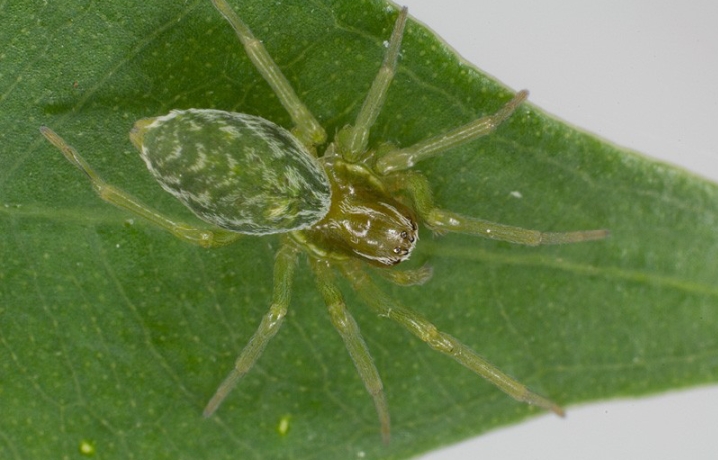
Green Mesh-webbed spider also referred to as Green Mesh-weaver is common across Europe, especially in Germany, France, Switzerland and the United Kingdom.
Nigma walckenaeri was first described by the Swiss entomologist Ludwig Carl Christian Koch in 1869. It belongs to the family Dictynidae, which is a diverse group of spiders commonly referred to as mesh-web weavers or mesh-webbed spiders. This family includes around 600 described species distributed worldwide.
In general, these spiders are relatively small in size, with a body length ranging from 4 to 6 millimeters. They have an elongated, slender body shape with long legs.
While most of the body is a somewhat yellowish, the abdomen is a shining green, which makes it rather distinct and hard to confuse with other species.
From August to October these spiders can be found in gardens or on walls – often on big leaves such as lilac or feral grapevine.
The spider catches insects, sometimes larger than itself, in its web, which it builds on the surface of leaves.
Unlike many other spider species that create elaborate orb webs, Nigma walckenaeri constructs a three-dimensional mesh-like web. The web consists of irregular crisscrossing threads that form a tangle of silk which is very effective in catching flying insects.
Facts Table
| Scientific Name | Nigma walckenaeri |
| Family | Dictynidae |
| Type | Mesh-webbed spider |
| Size | 4-6 millimeters |
| Lifespan | Up to 18 months |
| Habitat | Gardens and Shrublands. |
| Hunting Technique | Camouflage and Active hunting |
| Breeding season | Summer months |
| Food | Flies, bees, wasps, beetles, cricket, mosquitoes, butterflies, moths, grasshoppers, flying insects and other spiders. |
| Predators | Birds, larger spiders, mantises, wasps Small Mammals and Reptiles. |
Lesser green lynx spider

The Lesser green lynx spider is a medium-sized spider is commonly found in Central America and the southern United States (Florida, Texas and parts of the Gulf Coast). It was first described by Frederick Octavius Picard-Cambridge in the year 1902.
Females are about 10 to 12 millimeters in length, while males are about 6 to 9 millimeters. Both sexes have a slender body shape with long, spiny legs. In general the spider’s body is green in color, though individuals from drier areas can have a yellow or brown coloration.
The Lesser green lynx spider is an active hunter that does not build webs to catch prey. The spider often positions itself on plants or flowers, waiting for potential prey and then moves swiftly, using its long legs to pounce.
When threatened, the spider may display aggressive behavior, raising its front legs and exposing its fangs in an attempt to intimidate predators.
Scientifically, it is considered a beneficial spider for gardeners and farmers as it feeds on agricultural pests such as aphids, caterpillars and leafhoppers.
Facts Table
| Scientific Name | Peucetia longipalpis |
| Family | Oxyopidae |
| Type | Lynx spider |
| Size | Female: 10-12 millimeters Male: 6-9 millimeters |
| Lifespan | Up to 12 months |
| Habitat | Grasslands, gardens, forests and agricultural areas. |
| Hunting Technique | Camouflage and Active hunting |
| Breeding season | Summer months |
| Food | Bees, flies, moths and small arthropods |
| Predators | Birds, larger spiders, mantises, wasps, Small Mammals and lizards. |
Speckled Orbweaver
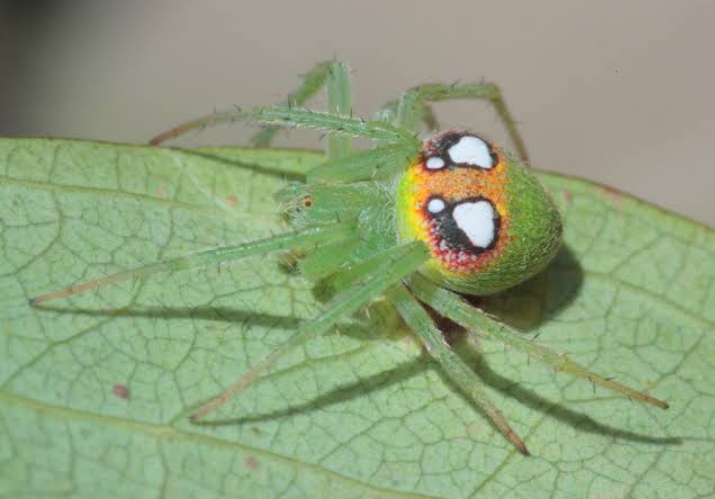
Commonly referred to as the Speckled Garden Spider or the Speckled Orb-weaving Spider has a wide distribution throughout Australia, Canada, United States and Central America.
These spiders are bright green with lighter specks and often a pretty red and yellow patch on the abdomen. Females are about 8 to 15 millimeters in length, while males are about 6 to 10 millimeters. The legs are long and slender.
Like other orb-weaving spiders, the Speckled Orb-weaver constructs intricate circular webs between shrubs, trees or other structures, utilizing strong silk threads that radiate from the center like spokes capture prey.
Speckled Orb-weavers face threats from predators such as birds, wasps and other spiders.
Males generally have shorter lifespans. They usually live for a few months, with an average lifespan ranging from 5 to 7 months. After mating, the female’s lifespan extends to several months (4 to 6 months).
Facts Table
| Scientific Name | Araneus circulissparsus |
| Family | Araneidae |
| Type | Orb-weaving spider |
| Size | Female: 8 to 15 millimeters Male: 6-10 millimeters |
| Lifespan | Up to 14 months |
| Habitat | Gardens, fields, meadows and forest edges. |
| Hunting Technique | Web Capture |
| Breeding season | Summer months |
| Food | Bees, flies, moths and small arthropods |
| Predators | Birds, larger spiders, mantises, wasps, Small Mammals and lizards. |
Slender green orbweaver
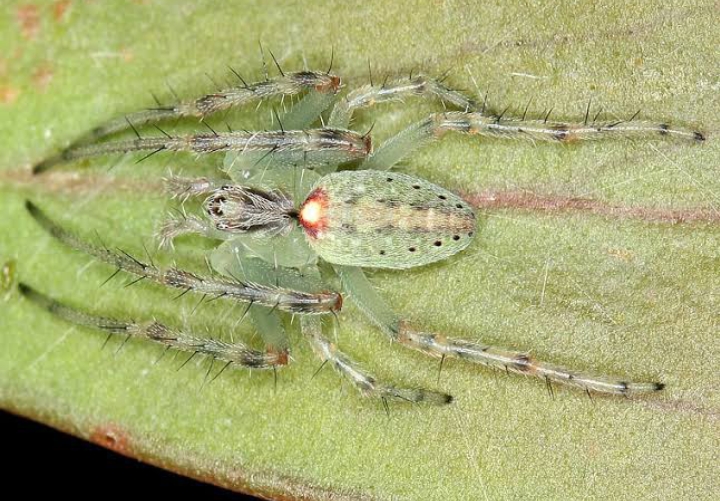
The slender green orb-weaver, scientifically known as Araneus talipedatus, is majorly found in various regions of Australia. As its name suggests, this spider has a slender body shape and it constructs an orb web to capture its prey.
The female is larger than the male, with a body length that can reach up to 9 mm, while males tend to be up to 7 mm. The legs and pedipalps of this species are covered in long hairs.
The spider has a vivid green body, which aids in camouflage among foliage and vegetation during hunting.
Male spiders can also exhibit red coloration on the abdomen but in the form of connected dots rather than in the form of parallel lines bordering a white central stripe.
The slender green orb-weaver builds a conventional orb web, which is a circular, intricate structure made of silk. It is usually active during the daytime.
Facts Table
| Scientific Name | Araneus talipedatus |
| Family | Araneidae |
| Type | Orb-weaving spider |
| Size | Female: up to 9 millimeters Male: up to 7 millimeters |
| Lifespan | Up to 12 months |
| Habitat | Gardens, fields, meadows and forest edges |
| Hunting Technique | Web Capture And Active Hunting |
| Breeding season | Summer months |
| Food | Bees, flies, moths and small arthropods |
| Predators | Birds, larger spiders, mantises, wasps, Small Mammals and lizards. |
Green Stretch Spider
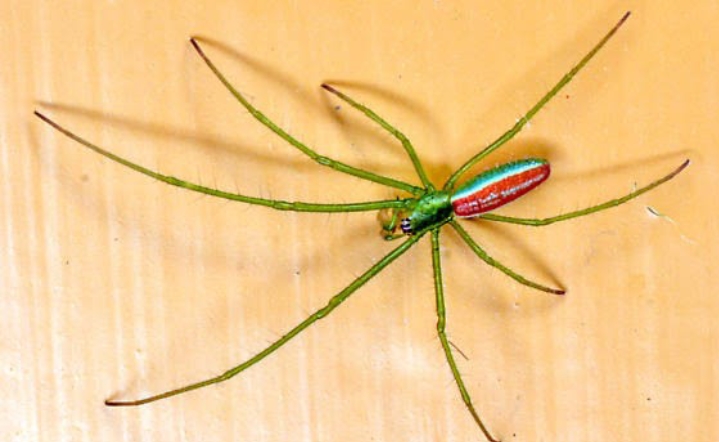
Green stretch spider commonly known as the green long-jawed spider (Tetragnatha viridis) is found in North America, Africa, Europe and Asia. It usually prefers wetland areas like marshes, swamps and the edges of lakes and ponds.
The body is elongated in shape with the abdomen being longer than the cephalothorax (the fused head and thorax). The legs are slender and long. Females are 6 to 9 mm in body length, while males can be around 5 to 7 mm.
As the common name suggests, Green Stretch Spider spiders is generally green in color, although the shade of green can vary. It has a green hue on the body, legs and eyes.
Green Stretch Spiders build their orb webs in areas with abundant vegetation, often near water sources. The web construction is horizontal and the spiders position themselves upside down, hanging from the web.
Facts Table
| Scientific Name | Tetragnatha viridis |
| Family | Tetragnathidae |
| Type | Long-jawed orb weaver |
| Size | Female: up to 9 millimeters Male: up to 7 millimeters |
| Lifespan | Up to 1 year |
| Habitat | Near water sources |
| Hunting Technique | Web Capture |
| Breeding season | Summer months |
| Food | Bees, flies and soft bodied insects |
| Predators | Birds, larger spiders, mantises, wasps, Small Mammals and lizards. |
Red-spotted Orb Weaver
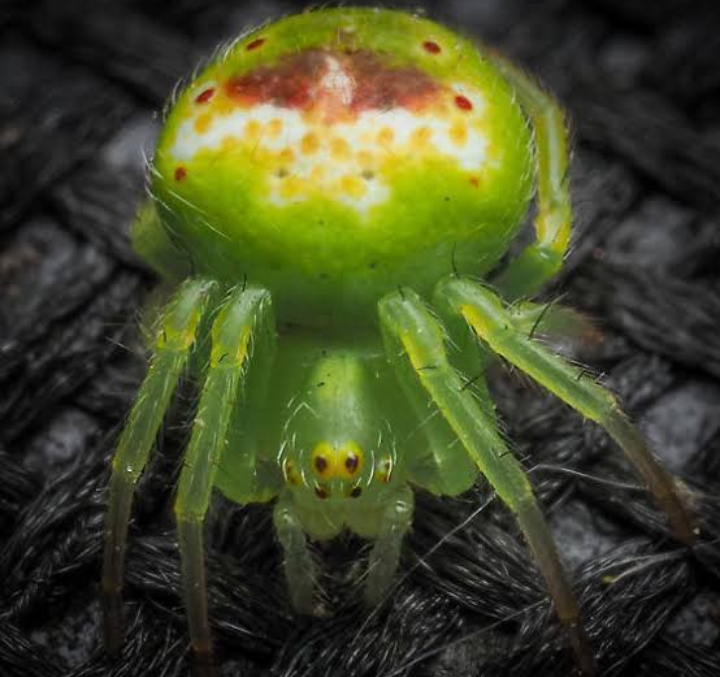
Red-spotted Orbweaver is a species of orb weaver commonly found in United States and parts of Europe, like the United Kingdom, Ireland, and continental Europe.
Like other orbweaver spiders, they possess eight long and slender legs, two pairs of spinnerets at the back end of their abdomen, and a cephalothorax (combined head and thorax region).
Their bodies are usually light green in color with red dots around the upper side of the abdomen. Females are about 8 to 12 millimeters in body length, while males are around 6 to 8 millimeters.
Their coloration and patterns allow them to blend into their surroundings and become difficult for predators to spot them.
These colorful spiders have a tendency to build their web at the top of trees. They are most active during the warmer months, from spring to autumn, and can often be observed during daytime hours.
Mating occurs in the autumn, and during this period males search for females by following pheromone trails left by the females.
When disturbed or threatened, they may vibrate their web rapidly to disorient potential predator or drop to the ground and play dead.
Facts Table
| Scientific Name | Araneus cingulatus |
| Family | Araneidae |
| Type | Orb weaver |
| Size | Female: up to 12 millimeters Male: up to 8 millimeters |
| Lifespan | Up to 14 months |
| Habitat | Orchards, gardens and woodland areas |
| Hunting Technique | Active hunting and Web Capture |
| Breeding season | Autumn months |
| Food | Bees, flies and soft bodied insects |
| Predators | Birds, larger spiders, mantises, wasps, Small Mammals and lizards. |
Grass Crab Spiders
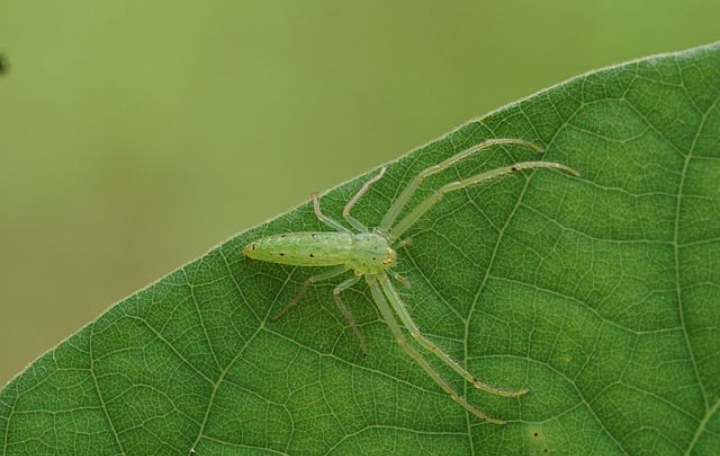
Grass crab spiders can be found in many parts of the world, including North America, Europe, Asia, Africa and Australia. These spiders have a unique body shape and ability to change color to blend with their surroundings.
They are relatively small in size compared to other spider species, with the body length ranging from 5 to 10 mm. They too have an almost transparent green color and a single yellow mark on top of the head.
Their bodies are laterally compressed with long, crab-like legs that extend sideways. Their front two pairs of legs are much larger and stronger than the hind pairs.
Like other crab spiders, they are masters of ambush and disguise. They stalk their prey at night, from an ambush position on a grass stem or from the underside of a leaf. They can sense the vibrations caused by invertebrates moving on the leaf’s upper side, and quickly pounce on the victim.
Grass crab spiders have been observed to ambush and capture prey much larger than themselves.
These spiders typically live for several months to a year.
Facts Table
| Genus | Oxytate |
| Family | Thomisidae |
| Type | Crab Spiders |
| Body Length (Size) | 5-10 mm |
| Lifespan | Up to 12 Months |
| Habitat | Shrublands, grasslands, and even low-growing vegetation |
| Hunting Technique | Active hunting |
| Breeding season | Autumn |
| Prey | bees, flies, butterflies, beetles, and other small arthropods. |
| Predators | Birds, Insectivorous Mammals, Larger spider, Praying Mantises, Wasps and Ants |
Also Read: Difference Between Tarantula And Spider
Hygropoda Spiders
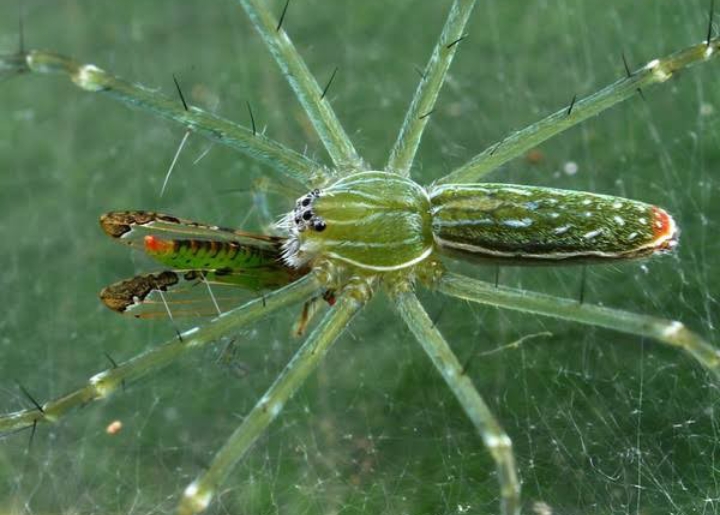
Hygropoda is a genus of nursery web spiders that was first described by Tamerlan Thorell in 1894. Species occur throughout the world except for extremely dry or cold environments, and are common just about everywhere.
In appearance, they resemble wolf spiders by the fact that they an elongated and relatively robust body shape.
Their bodies are light to dark green in coloration. The size of these spiders can vary, but females will always be larger than males.
Adult female specimens may reach up to 15mm in length, excluding legs. The legs of the male are longer in relation to body size than those of the female.
They are known to inhabit wetland areas, such as ponds, swamps, and marshes.
Many can walk on the surface of still bodies of water and may even dive beneath the surface temporarily to escape enemies.
They can jump a distance of 5 to 6 inches (130 to 150 mm), but they have trouble climbing extremely smooth surfaces such as glass.
Like other nursery web spiders, female Hygropoda spiders construct a nursery web to protect their eggs and spiderlings.
They are active hunters and primarily feed on small invertebrates found in their habitat.
Facts Table
| Genus | Hygropoda |
| Family | Pisauridae |
| Type | Nursery web spiders |
| Body Length (Size) | 9-15 mm |
| Lifespan | Up to 1 Year |
| Habitat | Aquatic and semi-aquatic habitats. |
| Hunting Technique | Active hunting |
| Breeding season | Autumn |
| Prey | bees, flies, butterflies, beetles, and other small arthropods. |
| Predators | Birds, Insectivorous Mammals, Larger spider, Praying Mantises, Wasps and Ants |